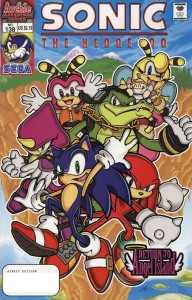 When Archie’s Sonic the Hedgehog first started, it worked on an extremely simple premise. Freedom Fighters, striking from a hidden base, have victory after victory against the evil Dr. Robotnik, although the status quo never changes. With no concern to follow continuity, the light-hearted, pun-centric stories could do whatever they wanted. But looking at the ambitious scope of the Saturday morning cartoon‘s second season, Ken Penders was inspired to transform the comic into something that could be even greater than what was seen on the airwaves.
When Archie’s Sonic the Hedgehog first started, it worked on an extremely simple premise. Freedom Fighters, striking from a hidden base, have victory after victory against the evil Dr. Robotnik, although the status quo never changes. With no concern to follow continuity, the light-hearted, pun-centric stories could do whatever they wanted. But looking at the ambitious scope of the Saturday morning cartoon‘s second season, Ken Penders was inspired to transform the comic into something that could be even greater than what was seen on the airwaves.
This was when Ken’s obsession with world building began. In a fictional universe, sometimes even the smallest details can help flesh it out. One look at the original Star Wars films, for example, proves just that. When Luke and Obi-Wan walk into the Mos Eisley Cantina in the first film, all these strange creatures from across the universe are sitting together, each with their own story, adventures that go far beyond what Luke Skywalker was doing. The audience didn’t need to know the name of every species or their occupations, simply the fact they existed gave it credence. This was a living, breathing universe that had existed long before the rebels stole the plans to the Death Star.
Introducing concepts and characters that could be revisited by other authors down the line was what Ken wanted to do. Build a living, breathing world where untold adventures and civilizations lay just beyond the horizon. He did this before Endgame, it was the expressed purpose of Brave New World, and the Knuckles series had new idea after new idea in almost every arc. Just coming up with a slew of ideas doesn’t automatically make them good, however. Sometimes, it can even bury the story you are trying to tell.